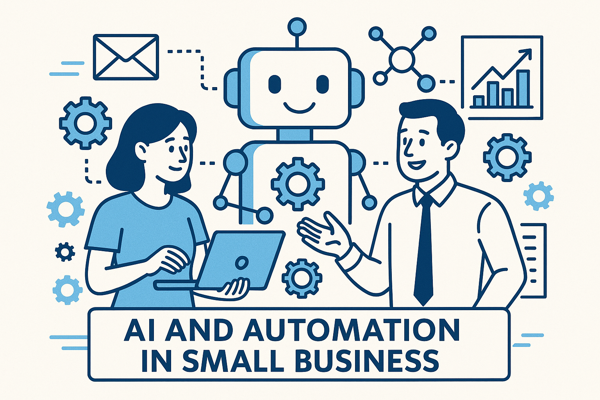Artificial intelligence (AI) and automation are no longer just for tech giants or massive factories. Today, even small businesses are discovering how these tools can help them save time, cut costs, and serve customers better. But there’s often one concern that comes up: “Will AI replace people?”
The good news is, AI and automation don’t have to take away jobs. Instead, they can make jobs easier, improve work quality, and allow small teams to focus on what they do best — all without losing the human touch.
What Are AI and Automation?
Let’s break it down simply. AI refers to machines or software that can mimic human thinking — like answering questions, sorting emails, or predicting what a customer might want. Automation means using technology to perform tasks without needing someone to do them manually — such as scheduling appointments or sending invoices.
When used correctly, these tools can support employees rather than replace them. Think of them as helpful assistants that work around the clock.
How Small Businesses Can Benefit
Small businesses often run on tight budgets and small teams. That’s why smart use of AI and automation can be a game-changer. Here’s how:
- Faster Customer Service: Chatbots can answer simple questions 24/7, allowing real staff to handle more complex needs.
- Smarter Marketing: AI can analyze customer behavior and send personalized emails or product suggestions, increasing sales.
- Better Scheduling: Automated tools can manage calendars, bookings, and reminders, cutting down on back-and-forth communication.
- Inventory Management: AI can help track stock levels and predict when to reorder, preventing waste and lost sales.
- Bookkeeping Support: Automated systems can categorize expenses, send invoices, and even flag unusual spending — saving time and reducing errors.
These tools aren’t meant to remove people from the equation. Instead, they free up time for more important tasks, like building relationships and growing the business.
Keeping the Human Touch
The biggest strength of small businesses is their personal connection with customers. That’s something no machine can fully replace. While AI can help with efficiency, customers still value human interaction — especially when things go wrong or when they want expert advice.
The key is balance. Use AI for repetitive tasks, and let your team focus on creativity, empathy, and problem-solving. For example:
- Use a chatbot to handle FAQs, but let customers easily reach a human when needed.
- Automate appointment confirmations, but follow up with a personal message or phone call when appropriate.
- Let AI suggest products, but make sure staff are ready to offer personalized recommendations.
By combining smart tools with real people, small businesses can offer fast, friendly, and memorable service.
Empowering Your Team, Not Replacing Them
Instead of thinking about how AI might take jobs away, consider how it can make your team’s work better. For example:
- Less Repetition: Employees can stop wasting time on data entry or routine emails.
- More Focus: With fewer distractions, staff can concentrate on strategy, customer relationships, and creative problem-solving.
- New Skills: Learning to use AI tools adds value to any employee’s skill set, opening up future career growth.
When staff feel supported rather than threatened by technology, they’re more likely to embrace it — and use it well.
Getting Started: Simple, Affordable Tools
You don’t need a big budget to start using AI and automation. Many tools are free or low-cost, and easy to use. Here are a few types to consider:
- Email marketing platforms (like Mailchimp or Brevo) with automation features
- Scheduling apps that book appointments or meetings without human input
- Chatbots for websites and social media pages
- Accounting tools with AI-driven insights
- CRM systems that automatically update contact information and track leads
Start with one or two tools that solve a real need in your business. Test them, involve your team, and adjust as needed.
Final Thoughts: Embrace the Help, Keep the Heart
AI and automation are not about replacing people — they’re about helping people do their jobs better. For small businesses, this means having more time, fewer mistakes, and happier customers, all while keeping the human connection that makes your business unique.
The future of small business doesn’t belong to robots. It belongs to people who are smart enough to use technology in ways that work for them — not against them.
